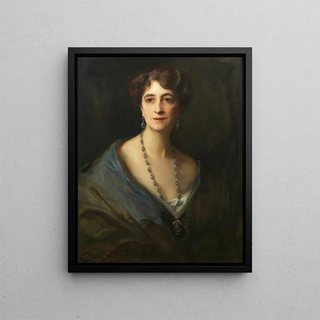Art print | Portrait of Lady Byng née Marie Evelyn Moreton - Philip Alexius de László


View from behind

Frame (optional)
The "Portrait of Lady Byng née Marie Evelyn Moreton" is an iconic piece that transcends the simple frame of painting to immerse the viewer in a universe of grace and elegance. Created by Philip Alexius de László, this masterpiece captures not only the beauty of its subject but also the very essence of the era in which it was created. Lady Byng, a figure of British high society, is depicted in a pose that evokes both dignity and delicacy, demonstrating the undeniable talent of the artist. This portrait, at the crossroads between realism and romanticism, invites deep contemplation, making each gaze a journey through time and emotion.
Style and uniqueness of the work
The style of Philip Alexius de László is distinguished by his meticulous attention to detail and his ability to capture the personality of his subjects. In the portrait of Lady Byng, the finesse of the features and the mastery of colors create an intimate atmosphere, where each nuance seems to vibrate with its own life. The sumptuous drapes of her dress, as well as the subtle play of light on her face, reveal a refined pictorial technique that demonstrates a profound understanding of textures and volumes. The artist succeeds in transcending mere representation, infusing his work with a psychological dimension, where the expression of the gaze and Lady Byng's posture tell a story — that of a strong and influential woman of her time.
The artist and his influence
Philip Alexius de László, of Hungarian origin, established himself on the international art scene in the early 20th century. Recognized for his portraits of eminent personalities, he made his mark by a pioneering approach that blends tradition and modernity. His work is often compared to that of the great masters of painting, while maintaining an originality that is uniquely his own. László surrounded himself with a prestigious clientele, ranging from aristocrats to celebrities, and his influence still endures today in the art world. Through his works, he redefined the art of portraiture.

Matte finish

View from behind

Frame (optional)
The "Portrait of Lady Byng née Marie Evelyn Moreton" is an iconic piece that transcends the simple frame of painting to immerse the viewer in a universe of grace and elegance. Created by Philip Alexius de László, this masterpiece captures not only the beauty of its subject but also the very essence of the era in which it was created. Lady Byng, a figure of British high society, is depicted in a pose that evokes both dignity and delicacy, demonstrating the undeniable talent of the artist. This portrait, at the crossroads between realism and romanticism, invites deep contemplation, making each gaze a journey through time and emotion.
Style and uniqueness of the work
The style of Philip Alexius de László is distinguished by his meticulous attention to detail and his ability to capture the personality of his subjects. In the portrait of Lady Byng, the finesse of the features and the mastery of colors create an intimate atmosphere, where each nuance seems to vibrate with its own life. The sumptuous drapes of her dress, as well as the subtle play of light on her face, reveal a refined pictorial technique that demonstrates a profound understanding of textures and volumes. The artist succeeds in transcending mere representation, infusing his work with a psychological dimension, where the expression of the gaze and Lady Byng's posture tell a story — that of a strong and influential woman of her time.
The artist and his influence
Philip Alexius de László, of Hungarian origin, established himself on the international art scene in the early 20th century. Recognized for his portraits of eminent personalities, he made his mark by a pioneering approach that blends tradition and modernity. His work is often compared to that of the great masters of painting, while maintaining an originality that is uniquely his own. László surrounded himself with a prestigious clientele, ranging from aristocrats to celebrities, and his influence still endures today in the art world. Through his works, he redefined the art of portraiture.






